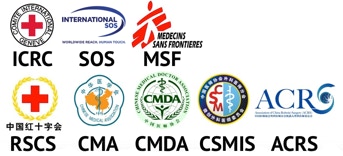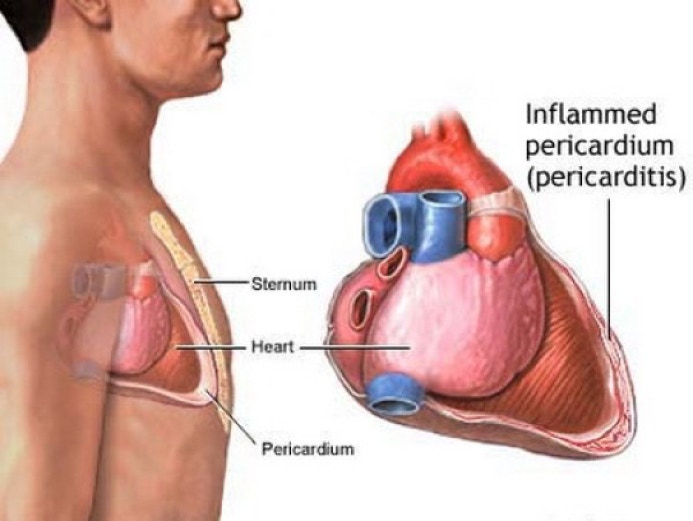

Doctors
Institutions
Conditions
Drugs
Insurances
TCM
Research
About Us
Contact Us
What is pericarditis?
Pericarditis is inflammation of the pericardium, the thin sac (membrane) that surrounds the heart.
The pericardium holds the heart in place and helps it work properly. There is a small amount of fluid between the inner and outer layers of the pericardium. This fluid keeps the layers from rubbing as the heart moves to pump blood.
What causes pericarditis?
Usually, the cause of pericarditis is unknown, but may include:
Infection (by viruses, bacteria, a fungus, or parasites)
Autoimmune disorders (such as lupus, rheumatoid arthritis, or scleroderma)
Inflammation after a heart attack
Chest injury
Cancer
HIV/AIDS
Tuberculosis (TB)
Kidney failure
Medical treatments (such as certain medicines or radiation therapy to the chest)
Heart surgery
What are the symptoms of pericarditis?
The following are the most common signs of pericarditis:
Chest pain that:
Can especially be felt behind the breastbone, and sometimes beneath the clavicle (collarbone), neck, and left shoulder
Is a sharp, piercing pain over the center or left side of the chest that gets worse when you take a deep breath and usually gets better if you sit up or lean forward
Feels a lot like a heart attack
Fever
Weakness and tiredness
Coughing
Trouble breathing
Pain when swallowing
Palpitations (irregular heartbeats)
The symptoms of pericarditis may look like other conditions. See a healthcare provider for a diagnosis.
How is pericarditis diagnosed?
If your healthcare provider suspects pericarditis, he or she will listen to your heart very carefully. A common sign of pericarditis is a pericardial rub. This is the sound of the pericardium rubbing against the outer layer of your heart. Other chest sounds that are signs of fluid in the pericardium (pericardial effusion) or the lungs (pleural effusion) may also be heard.
Along with a complete medical history and physical exam, tests used to diagnose pericarditis may include:
Echocardiogram (echo). This test uses sound waves to check your heart's size and shape. The echo sound waves create a picture on a screen as an ultrasound transducer is passed over the skin over the heart. Echo can show how well your heart is working and whether fluid has built up around your heart.
Electrocardiogram (ECG). This test records the strength and timing of the electrical activity of the heart. It shows abnormal rhythms and can sometimes detect heart muscle damage. Small sensors are taped to your skin to pick up the electrical activity.
Chest X-ray. An X-ray may be done to check your lungs and see if your heart is enlarged.
Cardiac MRI. This is an imaging test that takes detailed pictures of the heart. It may be used to look for thickening or other changes in the pericardium.
Cardiac CT. This type of X-ray takes a clear, detailed picture of your heart and pericardium. It may be used to help rule out other causes of chest pain.
Blood tests. Certain blood tests can help rule out other heart problems, such as heart attack, and can tell the doctor how much inflammation there is in your pericardium.
How is pericarditis treated?
Your healthcare provider will figure out the best treatment based on:
How old you are
Your overall health and medical history
How sick you are
How well you can handle specific medicines, procedures, or therapies
How long the condition is expected to last
Your opinion or preference
The goal of treatment for pericarditis is to determine and eliminate the cause of the disease. Treatment often involves medicines, such as pain medicines, anti-inflammatory drugs, or antibiotics.
If serious heart problems develop, treatment may include:
Aspiration or removal of excess fluid around the heart
Surgery
Pericarditis may last from 2 to 6 weeks, and it may come back.
What are the complications of pericarditis?
There is a small amount of fluid between the inner and outer layers of the pericardium. Often, when the pericardium becomes inflamed, the amount of fluid between these layers increases. This is called a pericardial effusion. If the amount of fluid increases quickly, the effusion can keep the heart from working properly. This complication of pericarditis is called cardiac tamponade and is a serious emergency. A thin needle or tube (called a catheter) is put into the chest to remove the fluid in the pericardium and relieve pressure on the heart.
Chronic constrictive pericarditis occurs when scar-like tissue forms throughout the pericardium. It’s a rare disease that can develop over time in people with pericarditis. The scar tissue causes pericardial sac to stiffen and not move properly. In time, the scar tissue squeezes the heart and keeps it from working well. The only way to treat this is to remove the pericardium with a special type of heart surgery.
When should I call my healthcare provider?
If your symptoms get worse or you have new symptoms, call your healthcare provider.
Key points
Pericarditis is inflammation of the pericardium, the thin sac that surrounds the heart.
Pericarditis may be caused by infection, autoimmune disorders, inflammation after a heart attack, chest injury, cancer, HIV/AIDS, tuberculosis (TB), kidney failure, medical treatments (such as certain medicines or radiation therapy to the chest), or heart surgery.
The most common signs of pericarditis include chest pain, fever, weakness and tiredness, coughing, trouble breathing, pain when swallowing, and palpitations (irregular heartbeats).
If pericarditis is suspected, the healthcare provider will listen to your heart very carefully. A common sign of pericarditis is a pericardial rub -- the sound of the pericardium rubbing against the outer layer of your heart.
The goal of treatment for pericarditis is to determine and eliminate the cause of the disease. Treatment often involves medicines, such as pain medicines, anti-inflammatory drugs, or antibiotics. If serious heart problems develop, treatment may include removal of excess fluid around the heart or surgery.
Pericarditis may last from 2 to 6 weeks, and it may come back.
Pericarditis can lead to complications such pericardial effusion (a buildup of fluid around the heart that can keep it from working properly) and chronic constrictive pericarditis (scar-like tissue forms throughout the pericardium which squeezes the heart and keeps it from working well).
Next steps
Tips to help you get the most from a visit to your healthcare provider:
Know the reason for your visit and what you want to happen.
Before your visit, write down questions you want answered.
Bring someone with you to help you ask questions and remember what your provider tells you.
At the visit, write down the name of a new diagnosis, and any new medicines, treatments, or tests. Also write down any new instructions your provider gives you.
Know why a new medicine or treatment is prescribed, and how it will help you. Also know what the side effects are.
Ask if your condition can be treated in other ways.
Know why a test or procedure is recommended and what the results could mean.
Know what to expect if you do not take the medicine or have the test or procedure.
If you have a follow-up appointment, write down the date, time, and purpose for that visit.
Know how you can contact your provider if you have questions.
















